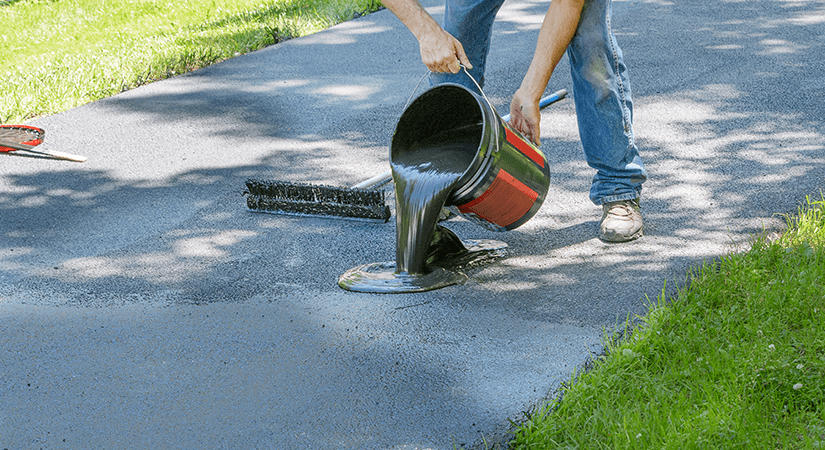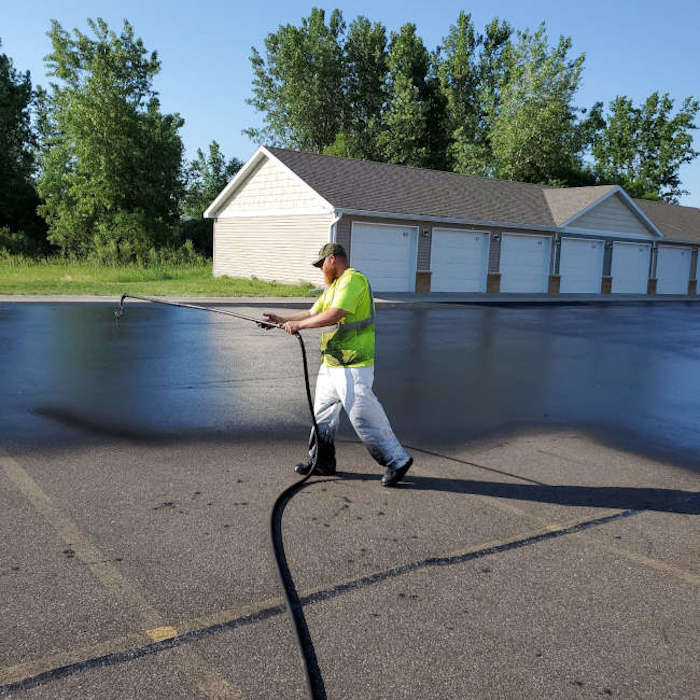Unleash the Possible: Regrading and Asphalt Sealing for Business Rooms
Wiki Article
Hot Mix Asphalt: A Sustainable Option for Pavement
Warm Mix Asphalt (HMA) has emerged as a leading sustainable choice for pavement remedies, offering a myriad of cutting-edge technologies and ecological benefits. As the demand for environmentally friendly building and construction methods grows, exploring the subtleties of HMA's sustainability can supply important understandings right into the future of sidewalk options.Environmental Advantages of Warm Mix Asphalt

Additionally, Warm Mix Asphalt helps to reduce metropolitan heat island impacts. Its dark color takes in sunlight, lowering the amount of heat showed back into the environment compared to lighter-colored sidewalks. This can reduce ambient temperatures in city areas, decreasing the demand for air conditioning and eventually decreasing power consumption.
On top of that, Hot Mix Asphalt adds to improved stormwater monitoring. Its permeable nature enables water to penetrate the pavement and charge groundwater products, minimizing overflow and the danger of flooding. These environmental advantages make Warm Mix Asphalt a sustainable selection for leading roads and freeways.
Energy Efficiency in HMA Production
Is energy efficiency a crucial consider the manufacturing of Hot Mix Asphalt (HMA)? Absolutely. Power plays a substantial duty in the production of HMA, influencing both expense and environmental sustainability. One key facet of power effectiveness in HMA manufacturing is using cozy mix asphalt (WMA) modern technologies (commercial parking lot paving). WMA permits the blending and placement of asphalt at lower temperature levels contrasted to conventional hot mix asphalt, causing decreased power consumption during production. This process not just decreases fuel use yet likewise lowers greenhouse gas discharges, making it a much more ecologically friendly option.In addition, advancements in plant innovations have caused more energy-efficient HMA manufacturing processes. Modern plants are made with attributes like recycled asphalt pavement (RAP) processing capacities, efficient heater systems, and improved insulation, all adding to power cost savings. By maximizing energy usage in HMA manufacturing, the sector can minimize its carbon footprint while maintaining high-grade pavement materials. Energy performance is, consequently, an important factor to consider in making certain the sustainability of Hot Mix Asphalt production.
Recyclability of Hot Mix Asphalt
The recyclability of Hot Mix Asphalt (HMA) is an essential element of its sustainability and lasting environmental influence. HMA is among one of the most recycled materials in the USA, with over 100 million heaps of reclaimed asphalt sidewalk (RAP) being recycled each year in brand-new sidewalk construction. Reusing HMA supplies numerous environmental benefits, such angled parking as minimizing the demand for virgin materials, lowering energy usage throughout manufacturing, and lowering the quantity of waste sent to landfills.The procedure of reusing HMA entails milling the existing sidewalk, squashing it right into smaller sized pieces, and blending it with brand-new aggregate and asphalt binder to create a recycled mix. This recycled mix can commonly do along with or perhaps far better than traditional HMA, while needing less basic materials and producing lower greenhouse gas exhausts. By integrating RAP into new sidewalk projects, road firms can preserve natural deposits, lower costs, and reduce the environmental footprint of roadway building and construction and upkeep activities. Overall, the recyclability of HMA plays a significant duty in promoting sustainable practices within the sidewalk market.

Long-Term Efficiency of HMA
Asphalt sidewalks demonstrate longevity and strength over a prolonged duration, showing the long-lasting efficiency of Hot Mix Asphalt (HMA) The long life of HMA can be associated to its capability to stand up to rush hour loads, severe climate problems, and the effects of aging. Studies have actually shown that properly designed and appropriately constructed HMA sidewalks can last for two decades or more with regular upkeep. The key to optimizing the long-term performance of HMA depends on using high-quality materials, following ideal techniques in construction, and executing efficient upkeep methods. Appropriate drainage, routine inspections, and timely repairs are important for preserving the structural stability of HMA pavements gradually. Additionally, developments in HMA innovation, such as making use of polymer-modified binders and warm mix asphalt, have better improved the longevity and long life of HMA pavements. By focusing on high quality construction and upkeep methods, HMA proceeds to verify itself as a sustainable and economical remedy for durable pavement infrastructure.
HMA: Longevity and Sustainability
Demonstrating both longevity and sustainability, Warm Mix Asphalt (HMA) has come to be a cornerstone in the building of resilient pavement facilities - commercial parking lot paving. HMA's resilience originates from its ability to withstand hefty lots, extreme climate condition, and high web traffic volumes, making it a trustworthy selection for highways, highways, and flight terminal runways. The composition of HMA, which usually consists of aggregates, binder, and filler, plays a crucial role in improving its longevity and resistance to put on and tear
In addition, HMA's sustainability depends on its recyclability and energy-efficient manufacturing procedure. The capacity to reuse recovered asphalt pavement (RAP) in brand-new HMA mixes lowers the demand for virgin products and reduces the environmental effect of pavement building and construction and upkeep. Additionally, the power performance of creating HMA depends on its lower blending temperatures compared to various other pavement materials, resulting in reduced energy usage and greenhouse gas discharges.
Conclusion
In verdict, warm mix asphalt (HMA) uses a sustainable solution for pavement with its eco-friendly qualities. HMA's recyclability, energy effectiveness in manufacturing, and long-lasting sturdiness make it an environment-friendly choice for roadway building and construction. By saving natural deposits, decreasing waste, and lowering greenhouse gas emissions, HMA plays an important duty in promoting sustainability in infrastructure advancement. Its capacity to minimize metropolitan warmth island results additionally underscores its significance in creating resistant and eco aware pavement systems.
HMA is one of the most recycled products in the United States, with over 100 million heaps of reclaimed asphalt pavement (RAP) being recycled each year in brand-new sidewalk building.The process of reusing HMA entails milling the existing sidewalk, crushing it right into smaller pieces, and mixing it with new aggregate and asphalt binder to create a recycled mix.Asphalt sidewalks show sturdiness and resilience over a prolonged duration, reflecting the long-lasting efficiency of Hot Mix Asphalt (HMA) In addition, advancements in HMA technology, such as the use of polymer-modified binders and warm mix asphalt, have actually even more improved the durability and longevity of HMA pavements. The capability to recycle redeemed asphalt sidewalk (RAP) in new HMA mixes lowers the need for virgin materials and reduces the environmental effect of sidewalk building and construction and maintenance.
Report this wiki page